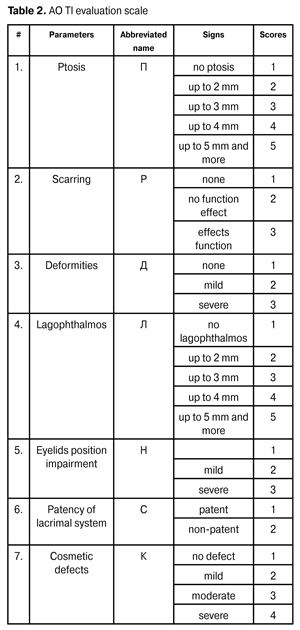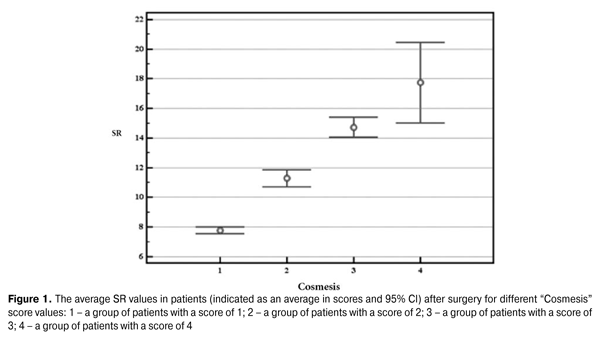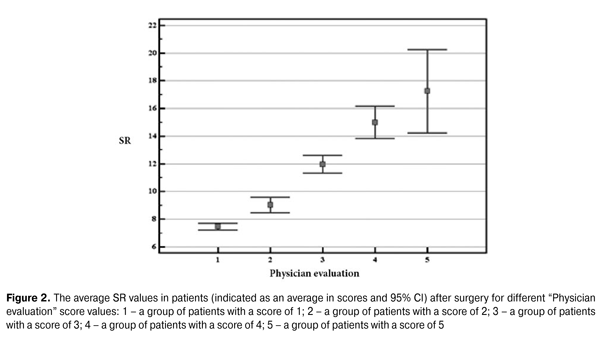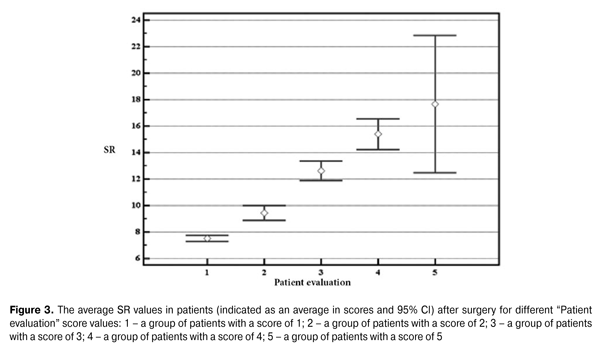J.ophthalmol.(Ukraine).2015;6:29-32.
|
https://doi.org/10.31288/oftalmolzh201562932 The method of evaluating the effectiveness of ocular adnexa traumatic injuries treatment G.D. Zhaboedov 1, Professor, Doctor of Medical Sciences O.V. Petrenko 2, Doctor of Medical Sciences 1 A. A. Bogomolets Medical University 2 P. L. Shupik National Medical Academy of Postgraduate Education Kiev (Ukraine) Е-mail: zhaboedov@ukr.net Keywords: evaluating method of treatment effectiveness, traumatic injuries, and ocular adnexa. Introduction. Development of the method of evaluating the effectiveness of ocular adnexa (OA) traumatic injuries treatment will allow determining the efficiency of the different treatment methods. Purpose is to develop the method of evaluating the effectiveness of ocular adnexa traumatic injuries treatment. Materials and methods. The study was conducted in 120 patients with ocular adnexa traumas. Patients were randomized in two representative groups by age and sex of 60 patients according to the reconstructive procedures methods. The results were evaluated in early and late postoperative period by proposed comprehensive system for ocular adnexa status evaluation using modern statistical methods. Results and discussion. The degree of ptosis, lagophthalmos, eyelids malposition, lacrimal patency, presence of scarring, deformities and cosmetic defects were taking into consideration in the evaluation of the ocular adnexa traumatic injuries treatment effectiveness. All indices were estimated in numerical score system. The result of ocular adnexa traumatic injuries treatment considered good when the index was from 7 to 11, satisfactory – from 12 to 16, unsatisfactory – from 17 to 20 scores according to the proposed scale. Conclusions. The use of the proposed method enables to compare the results of different methods of reconstructive procedures along with determination of the ophthalmosurgery effectiveness in patients with ocular adnexa traumatic injuries.
Introduction Research paper analysis on reconstructive ophthalmoplasty showed the need to establish the method of evaluating the effectiveness of ocular adnexa (OA) traumatic injuries (TI) treatment based on anatomic and topographic features of its structure in terms of determining its functional and cosmetic status [1, 5]. Based on the statistical data processing we have proposed a comprehensive system for the case follow-up as to the AO changes after traumatic injuries, which can be applied to determine the surgical interventions effectiveness [4]. In order to facilitate the evaluation of the results, taking into account individual anatomical features in the AO structure, the main AO functional and cosmetic status values were converted into scale scores. Based on the previous microsurgery, functional and plastic anatomy studies, the anatomical for evaluating the AO reconstructive surgical procedures included the following symmetry criteria: eyebrows, palpebral lines, orbito- palpebral sulcus, eye slits and lacrimal points; eyebrows, eyelid skin and edge damages, and tarsal plates; breaks in the eyelids ligaments and lacrimal ducts. AO functional parameters in case of traumatic injuries included an objective visual organ motor, lacrimal apparatus and passages evaluation. The study of the effects of delayed therapy in specialized departments evaluated the state of scars and deformities. AO cosmetic evaluation included cosmesis criteria definition using “computer cosmetimetry” developed in Eye Injuries Unit at the Helmholtz Moscow Research Institute of Eye Diseases. [6]. The physician's evaluation of the patient in the postoperative period were also considered (Table 1).
Purpose: to develop the method of evaluating the effectiveness of ocular adnexa traumatic injuries treatment. Materials and methods The work was carried out on the basis of the Ophthalmology Department at the A. A. Bogomolets’ National Medical University – Ophthalmology Unit of the Eye Injury Center in Aleksandrovka Clinical Hospital of Kiev within the period of 2007 - 2014. The work is based on treatment and follow-up of 120 (120 eyes) patients with AO traumatic injuries. There were 100 (83.3 ± 3.4) % of men and 20 (16.7 ± 3.4) % of women. The average age was (32.0 ± 3.0) years. Damages occurred due to the car accidents, trauma caused by construction tools, fireworks, resulted from the firing of various weapons, animal bites, etc. The complex examination included both traditional and special ophthalmologic examination methods. The results were recorded in specifically developed “Patients with visual organ and AO trauma examination map” based on evaluation of AO anatomical, functional and cosmetic parameters. Reconstructive surgical procedures were performed immediately after the injury. Depending on the surgical technique the patients were randomized into two representative groups by sex and age, 60 patients in each. The first group was subjected to the traditional reconstruction method for AO traumatic injuries described in many textbooks [2, 7], second – proposed morpho-functional (MF) method, based on a differentiated integrated approach taking into account the anatomical features of the AO structure in terms of reconstructive ophtalmoplasty, types of damaging agents, factors affecting the functional and cosmetic reconstruction results, individual plasty method selection by computer depending on the size, depth and location of the defect. The results were evaluated in the early and late postoperative period, which exceeded a month after the surgery. In order to evaluate the treatment results we have selected from the common database the most informative AO status functional and cosmetic features and developed the scale and formula for the proposed scoring scale (Table. 2).
For ease of the scale use the following abbreviations of names are used - П Р Д Л Н С К. The scale values are used by the formula: SR = Пх + Рх + Дх + Лх + Нх + Сх + Кх, where: SR – AO TI treatment success rate; x - evaluation score. The estimation of SR values for 120 post-operative patients was performed. The AO TI treatment result was considered good if was within the range of 7 - 11, satisfactory – 12 - 16, unsatisfactory – 17 - 20 points according to the proposed AO TI treatment success rate scale. The comparative analysis was performed to evaluate the proposed SR validity obtained after the treatment of the 120 patients against “Cosmesis”, “Physician assessment”, “Patient assessment” scales with SR score of the same patient. Biostatistics methods were used for the obtained study results analysis [3]. Results Fig. 1 shows the mean values and SR data spread depending on “Cosmesis” score –analysis result (Kruskal-Wallis test), which shows that the average SR for different “Cosmesis” scores was statistically significantly different (p <0.001).
Correlation analysis showed a strong positive relationship between SR and “Cosmesis” score (Spearmen's rank-order correlation, ?=0.92, was statistically significantly different from zero, p <0.01), i.e. the AO TI surgical treatment success rate (SR - from 7 to 11 scores) corresponds to a lower “Cosmesis” score when there is no cosmetic defect or it is of mild manifestation, and vice versa, poor treatment result (SR - from 17 to 20 scores) corresponds to a higher “Cosmesis” score. Figure 2 shows the mean values and SR data spread depending on “Physician assessment” score – analysis result (Kruskal-Wallis test), which shows that the average SR for different “Physician assessment” scores was statistically significantly different (p < 0.001).
Correlation analysis showed a strong positive relationship between SR and “Physician assessment” score (Spearmen's rank-order correlation, ?=0.87, was statistically significantly different from zero, p <0.01), i.e. the AO TI surgical treatment success rate (SR - from 7 to 11 scores) corresponds to a lower “Physician assessment” score. Fig. 3 shows the mean values and SR data spread depending on “Patient assessment” score – analysis result (Kruskal-Wallis test), which shows that the average SR for different “Patient assessment” scores was statistically significantly different (p < 0.001).
Correlation analysis showed a strong positive relationship between SR and “Patient assessment” score (Spearmen's rank-order correlation, ?=0.88, was statistically significantly different from zero, p <0.01), i.e. the AO TI surgical treatment success rate (SR - from 7 to 11 scores) corresponds to a lower “Patient assessment” score. Based on the proposed comprehensive AO status evaluation system the method was developed for the first time of evaluating the effectiveness of ocular adnexa traumatic injuries treatment, taking into account the anatomical and functional and aesthetic. AO TI surgical treatment results analysis showed that the application of the traditional reconstruction method provides the success rate scored “good” (SR - from 7 to 11 scores) in 18 (30.0 ± 5.9%) patients, “satisfactory” (SR - 12 to 16 scores) in 20 (33.3 ± 6/1%), and “unsatisfactory” (SR - from 17 to 20 scores) in 22 (36.7 ± 6.2%) patients. With the application of the proposed method the success rate scored “good” (SR - from 7 to 11 scores) was achieved in 55 (91.7 ± 3.6%) of patients, “satisfactory” (SR - 12 to 16 scores) in 3 (5.0 ± 2.8%) and “unsatisfactory” (SR - from 17 to 20 scores) in 2 (3.3 ± 2.3%) of patients. The analysis demonstrates the validity of the proposed SR scale and possibility to use to for evaluating the treatment effectiveness. Conclusions The scale was developed to evaluate the ocular adnexa traumatic injuries based on a their comprehensive assessment, taking into account the anatomical, functional and aesthetic , according to which the surgical treatment results can be considered “good” if scored within 7 - 11, “satisfactory” – 12 – 16 and “unsatisfactory” – 17 - 20 range. References
|





